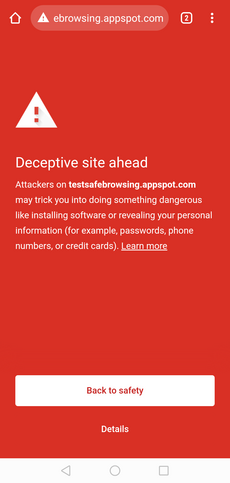Software:Google Safe Browsing
 | |
| Original author(s) | |
|---|---|
| Developer(s) | |
| Operating system | Android, ChromeOS, Windows, macOS, iOS |
| Type | Internet Security |
| Website | safebrowsing |
Google Safe Browsing is a service from Google that warns users when they attempt to navigate to a dangerous website or download dangerous files. Safe Browsing also notifies webmasters when their websites are compromised by malicious actors and helps them diagnose and resolve the problem. This protection works across Google products and is claimed to “power safer browsing experiences across the Internet”.[1] It lists URLs for web resources that contain malware or phishing content.[2][3] Browsers like Google Chrome, Safari, Firefox, Vivaldi, Brave, and GNOME Web use these lists from Google Safe Browsing to check pages against potential threats.[4][5] Google also provides a public API for the service.[6]
Google provides information to Internet service providers, by sending email alerts to autonomous system operators regarding threats hosted on their networks.[3] As of September 2017, over 3 billion Internet devices are protected by the service.[7] Alternatives are offered by both Tencent and Yandex.[8]
Clients protected
- Web browsers: Google Chrome, Safari, Firefox, Vivaldi, Brave, and GNOME Web.
- Android: Google Play Protect, Verify Apps API
- Google Messages
- Google Search
- Google AdSense
- Gmail
Privacy
Google maintains the Safe Browsing Lookup API, which has a privacy drawback: "The URLs to be looked up are not hashed so the server knows which URLs the API users have looked up". The Safe Browsing Update API, on the other hand, compares 32-bit hash prefixes of the URL to preserve privacy.[9][10] The Chrome, Firefox, and Safari browsers use the latter.[11]
Safe Browsing also stores a mandatory preferences cookie on the computer.[12]
Google Safe Browsing "conducts client-side checks. If a website looks suspicious, it sends a subset of likely phishing and social engineering terms found on the page to Google to obtain additional information available from Google's servers on whether the website should be considered malicious". Logs, which include an IP address and one or more cookies, are kept for two weeks and are tied to the other Safe Browsing requests made from the same device.[13]
In most applications, excluding Apple's Safari in which Apple uses a proxy system, the API is installed in a way that allows Google to continuously get the actual IP address of the user.[14] This enables Google to track users as they navigate the internet, send emails to Gmail accounts, or use Google services.
Criticism
Websites not containing malware have been blacklisted by Google Safe Browsing due to the presence of infected ads. Requesting removal from the blacklist requires the webmaster to create a Google Webmaster's Tool account and wait several days for the removal from the blacklist.[15] There have also been concerns that Google Safe Browsing could be used for censorship in the future, however this has not yet happened.[16]
See also
References
- ↑ "Google Safe Browsing" (in en). https://safebrowsing.google.com/.
- ↑ Schwartz, Barry (May 23, 2008). "Google's Safe Browsing Diagnostic Tool". Search Engine Land. http://searchengineland.com/googles-safe-browsing-diagnostic-tool-14064.
- ↑ 3.0 3.1 Constantin, Lucian (Dec 2, 2011). "Google Safe Browsing Alerts Network Admins About Malware Distribution Domains". PCWorld.com. https://www.pcworld.com/article/245373/google_safe_browsing_alerts_network_admins_about_malware_distribution_domains.html.
- ↑ "Firefox Phishing and Malware Protection". Mozilla Foundation. https://support.mozilla.org/en-US/kb/how-does-phishing-and-malware-protection-work.
- ↑ "Phishing and malware detection". Google Inc.. https://support.google.com/chrome/bin/answer.py?hl=en&answer=99020.
- ↑ "Safe Browsing API". Google Inc.. https://developers.google.com/safe-browsing/.
- ↑ "Safe Browsing: Protecting more than 3 billion devices worldwide, automatically". The Google Blog. September 2017. https://www.blog.google/technology/safety-security/safe-browsing-protecting-more-3-billion-devices-worldwide-automatically/.
- ↑ Gerbet, Thomas; Kumar, Amrit; Lauradoux, Cedric (June 2016). "A Privacy Analysis of Google and Yandex Safe Browsing". 2016 46th Annual IEEE/IFIP International Conference on Dependable Systems and Networks (DSN). Toulouse, France: IEEE. pp. 347–358. doi:10.1109/DSN.2016.39. ISBN 978-1-4673-8891-7. https://hal.inria.fr/hal-01120186/file/RR8686.pdf.
- ↑ "Developer's Guide (v3)". Google Developers. 18 March 2015. https://developers.google.com/safe-browsing/developers_guide_v3.
- ↑ "Safe Browsing API - Google Developers". Google Developers. 18 March 2015. https://developers.google.com/safe-browsing/.
- ↑ Bott, Ed. "Did Google withhold malware protection details from partners?". ZDNet. http://www.zdnet.com/blog/bott/did-google-withhold-malware-protection-details-from-partners/4484.
- ↑ "Cookies from Nowhere". Ashkan Soltani. 25 February 2012. http://ashkansoltani.org/2012/02/25/cookies-from-nowhere/.
- ↑ "Google Chrome Privacy Whitepaper". google.com. https://www.google.com/intl/en/chrome/browser/privacy/whitepaper.html.
- ↑ "Apple redirects Google Safe Browsing traffic through its own proxy servers to prevent disclosing users' IP addresses to Google in iOS 14.5". 9 February 2021. https://the8-bit.com/apple-proxies-google-safe-browsing-privacy/.
- ↑ "Google Safe Browsing Makes the Innocent Look Guilty" (in en). PCWorld. https://www.pcworld.com/article/192808/google_safe_browsing_makes_the_innocent_look_guilty.html.
- ↑ "The New Censorship". 22 June 2016. https://www.usnews.com/opinion/articles/2016-06-22/google-is-the-worlds-biggest-censor-and-its-power-must-be-regulated.
External links


